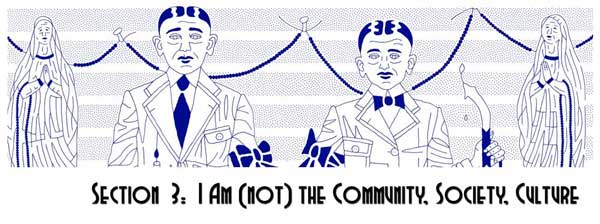a literary journal published by the Black Earth Institute dedicated to re-forging the links between art and spirit, earth and society

Human beings are communal animals. Biologists these days argue that homo sapiens’ ability to cooperate propelled humans to the top of the food chain and led inexorably to the founding of civilization: cities, art, religion, science and, of course, war.
The construction of any community requires developing ways to harness the unique creative energy of individuals while at the same time binding them into the collective. Justice is an attempt to find the right balance between individual freedom and the needs of the collective of other individuals. Freedom of speech requires a similar balance; the history of Supreme Court decisions about free speech (that it doesn’t include shouting fire in a crowded theater when there isn’t a fire) shows how difficult it is to locate the elusive fulcrum point that will establish balance between individual and collective. One might view the bitter differences between the Republicans and Democrats as a matter of their differing emphases on the poles of the primal paradox: one believes in promoting the self-reliant individual, the other believes in promoting the welfare of all. Neither of these positions can be absolute and both sides contradict themselves on their positions in given contexts. Meanwhile, the fundamental question, “Where is the balance?” is hardly ever straight forwardly discussed.
In light of the primal paradox, our ability to manage the self/other relationship by forming cooperative teams is counterbalanced by a weakness that turns us into mobs or splinters grand collective activity into belligerent subgroups. Reaction to the primal paradox seems to drive a repeated process of communal fragmentation. For example, an individual extends his “I” to join the larger group, but then finds that a smaller subgroup of individuals seems to more closely mirror his own self interest. This smaller group then may attain the power of a magnified self and may oppose or subvert the original larger group. Quickly the two groups enter into conflict with each other as if they were two separate selves. In this way religions and nations fall into destructive struggles with “other” religions and nations and are riven from within by civil strife.
Smaller traditional societies have used ritual and ceremony to return members to awareness of their dual nature as individuals and as a collective, including the vast collective of nature and cosmos. Human communities will continue to fragment and coalesce in patterns of conflict unless they can find ways to embrace the human contradiction that I am a separate me, but I am also the collective other that includes humanity and Gaia (animals, plants, even minerals).
©2025 Black Earth Institute. All rights reserved. | ISSN# 2327-784X | Site Admin